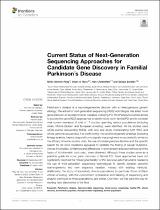| dc.description.abstract | Parkinson’s disease is a neurodegenerative disorder with a heterogeneous genetic etiology. The advent of next-generation sequencing (NGS) technologies has aided novel gene discovery in several complex diseases, including PD. This Perspective article aimed to explore the use of NGS approaches to identify novel loci in familial PD, and to consider their current relevance. A total of 17 studies, spanning various populations (including Asian, Middle Eastern and European ancestry), were identified. All the studies used whole-exome sequencing (WES), with only one study incorporating both WES and whole-genome sequencing. It is worth noting how additional genetic analyses (including
linkage analysis, haplotyping and homozygosity mapping) were incorporated to enhance the efficacy of some studies. Also, the use of consanguineous families and the specific search for de novo mutations appeared to facilitate the finding of causal mutations.
Across the studies, similarities and differences in downstream analysis methods and the types of bioinformatic tools used, were observed. Although these studies serve as a practical guide for novel gene discovery in familial PD, these approaches have not significantly resolved the “missing heritability” of PD.We speculate that what is needed is the use of third-generation sequencing technologies to identify complex genomic rearrangements and new sequence variation, missed with existing methods. Additionally, the study of ancestrally diverse populations (in particular those of Black African ancestry), with the concomitant optimization and tailoring of sequencing and analytic workflows to these populations, are critical. Only then, will this pave the way for exciting new discoveries in the field. | en_US |

